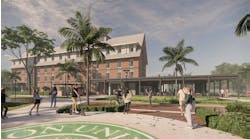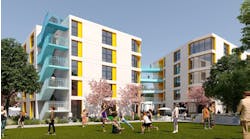Whether you're in the midst of executing a campus master building plan or just starting to upgrade those tired residence halls, dollars on most campuses are tight, and wish lists are long. Yet, it is possible to get a great return on even a limited investment. How? Sharpen your focus on six key areas that truly add value for — and attract — students.
-
Bathrooms
Updated and more private bathrooms continue to be a trend on campuses. Yet, many older residence halls were designed with the opposite in mind. If you can't afford to fully reconfigure a building, concentrate your efforts on remodeling the bathrooms — that's likely to provide the biggest bang for the buck in terms of student satisfaction.
When planning an upgrade, it's critical to understand usage patterns. If a majority of residents are starting their days around the same time, improve the ratio of showers to students and ensure adequate hot water for the capacity of the building. Upgrading fixtures and adding private changing areas adjacent to showers are two more ways that a bathroom renovation can improve the living experience.
New bathrooms also can potentially streamline custodial or maintenance operations; mitigate concerns over viruses, bacteria and mold; and contribute to sustainability goals by conserving energy and water.
-
Building entry areas
First impressions really do matter. How people enter a building and what they see from the outside create its sense of identity. This building "brand" informs the perceptions of students, prospective students and parents about what they'll find inside, and about campus life overall. What can they see from the front door or windows? Is the building attractive? Is there energy and activity? Arranging heavy activity areas and social spaces in the front of the building, for example, sends a clear message that something interesting is going on within those walls.
Building entries also must take the practical into account. Pay attention to functional security and be sure to include a central reception area. The configuration of the entry — the wayfinding, the location of mailboxes, the feeling of safety — can help connect students to the goings-on within the building, making them feel at home and communicating a strong message of serving student needs.
-
Transition spaces
In-between spots such as elevators, elevator lobbies, corridors and the doorway views into individual rooms rarely are discussed as must-haves. Yet, the path of travel through a building is, in essence, a series of "rooms," each with its own experience. Careful design of these spaces can affect student perceptions of a building significantly and improve its overall feel. In residence halls, it's often "all about the rooms," but when students have to take a rickety elevator and walk down grimy halls to get to that room, their experience of living in that space is diminished.
Just as a great social lounge improves the sense of community, so, too, do well-designed transitional spaces. If those places are situated centrally and pleasant to be in, students are more likely to stop and talk to one another. When designing or remodeling these spaces, look at visual rhythm, pattern and opportunities to add or reflect daylight or create views to the outdoors. Even simple fixes such as paint and changing out lighting can make a big difference. As a result, the building is perceived as a welcoming place that supports informal interactions and learning.
-
Green design
Addressing energy goals and daylighting in the programming statement and adopting LEED standards may not save money upfront, but it will help create a building that works efficiently from the start. Going green doesn't always cost more, but when it does, paying upfront for better infrastructure and materials saves money on energy usage and maintenance down the road.
Green design, especially those measures that address indoor air quality and natural light, creates more healthful buildings, which can improve the physical and emotional health of occupants. According to the U.S. Environmental Protection Agency (EPA), poor indoor air quality is linked to an array of preventable illnesses such as colds, flu, headaches, eye irritation, allergies and asthma, and has been shown to hinder intellectual processing tasks such as logical reasoning, memory and creative thinking.
-
Technology
Providing adequate infrastructure and amenities for today's wireless lifestyle has become non-negotiable. It may be a factor in whether a student opts to return to a residence hall.
For today's laptop-toting digital natives, technology is lifestyle. It shows in the trend toward residence-based "community learning centers," technology-rich spaces reserved for student study and group work. They might feature video-production equipment; access to community computers loaded with software that students are unlikely to own; projectors and screens; large-format printers; research assistance; learning programs and plenty of ports for students to plug in their laptops and collaborate — all available at a wide range of hours, if not 24-7.
To keep pace with the changes in technology, an education institution's technology infrastructure should be flexible enough to be adapted over time. While adding the new, be sure to audit items that may not be relevant anymore, such as phone jacks in student rooms.
-
Interactive spaces that promote learning and socializing
If a campus values living-learning communities, then its buildings should support — not work against — that objective. That means living rooms, gaming rooms, small spaces for group study and performing-arts studios — small, multipurpose rooms that reflect the lifestyles of today's students. Although it may be easier to add these spaces in new buildings, interactive spaces also can be incorporated into interior remodel plans for older buildings.
Community spaces enhance learning opportunities and create a common identity and culture. They establish shared interest and belonging, factors that have been shown to make people happier in their environment. In extensive research on the psychosocial effect of building environments, Judith Heerwagen has illustrated that people thrive in places that facilitate spontaneous social encounters and information-sharing, and where there is a balance between private spaces and those that encourage interaction.
In today's economic climate, schools can't do it all, but with smart spending, they can enact transformational changes on a limited budget. The goal is to create attractive spaces where students can live and learn — places where they will stay and thrive.
Zhiri, AIA, LEED AP, is a principal and leader of the Student Life design studio at Treanor Architects, Lawrence, Kan. She can be reached at [email protected].
Related Stories
Strategic focus, big impact
Remodeling an older residence hall can pose unique challenges, but it doesn't have to bust the budget. Two examples of how campuses tightened their focus to transform their buildings:
-
At Stephens College, a private women's college in Columbia, Mo., the Georgian-style Wood and Columbia Halls had not functioned as residence halls for years. Growing enrollment prompted the school to use the buildings again as student housing. Campus leaders faced a double challenge: to affordably modernize the halls within the $5.2 million budget and to work within the limits posed by their status on the National Register of Historic Buildings.
The design focused on those areas that would be most immediate to student satisfaction. Single rooms were transformed into a group of two- and four-bed apartments or one- and two-bedroom suites. High-priority areas such as upgraded baths, new kitchens, computer labs and a fitness center made the halls friendlier to today's lifestyles. Transitional spaces got a makeover — new elevators, better lighting and updated interiors, including restoration of the original high ceilings. The halls, which are situated near one another on the campus quad, now house up to 155 upperclasswomen.
-
On the campus of the University of Kansas, Margaret Hashinger Hall was a well-loved, but tired 1960s residence hall that had been built as a woman's residence hall, but in recent years had become the residence of choice for fine-arts students. The original design lacked the program spaces necessary to support fine-arts students.
Campus leaders and students wanted to retain the character of the building while making upgrades. In this case, bedrooms and bathrooms were left intact upon student request. Improvements were made across the building, but certain high-value areas were prioritized: interactive spaces, entry areas, technology relevant to fine-arts students and green design elements such as re-use of materials, improved daylighting and views to the outdoors.
Today, Hashinger Hall is a bustling arts community housing 385 students. A multipurpose theater with movable seating, a temporary stage, entry lobby and large storage areas serves as performance center, gallery and lobby. Acoustically separate music rooms, painting and textile rooms, a design resource center, dance studio, and conference and study rooms enable round-the-clock creativity.
Students socialize in an intimate lounge with a fireplace that reuses limestone removed from the pre-renovated Hall. On either side of the fireplace, doors open to the food-service deck, where diners appreciate panoramic views of the main campus.

